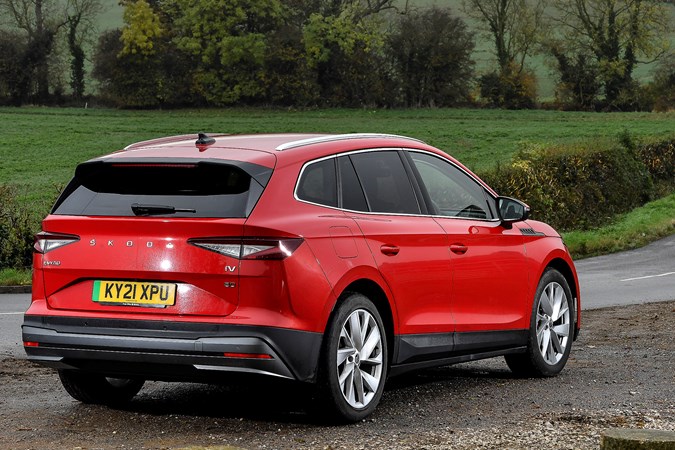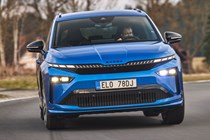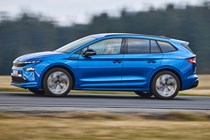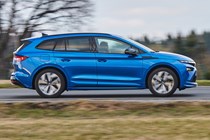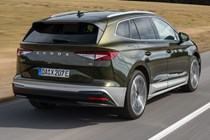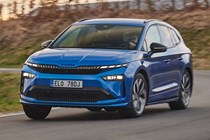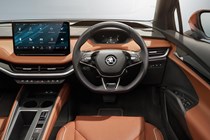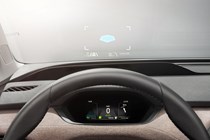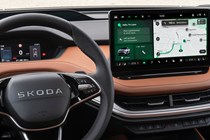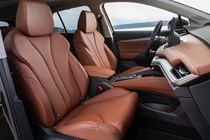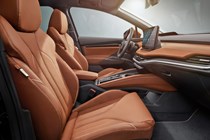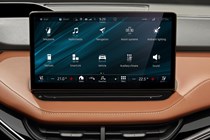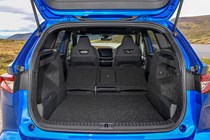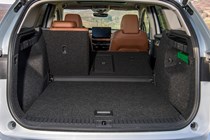
Skoda Enyaq long-term test
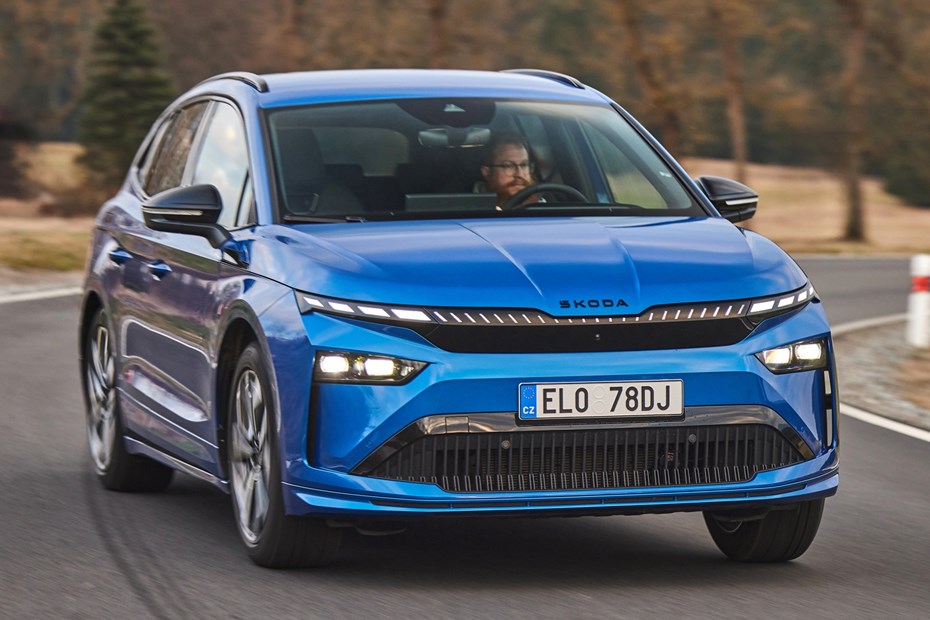
Parkers Editor, Keith Adams (below), ran a Skoda Enyaq iV for 10,000 miles to see if a long-distance driver can really live with an electric car. With its long claimed battery range and huge interior – as well as all the driver-assistance tech you can shake a stick at – there’s certainly a lot going for it.
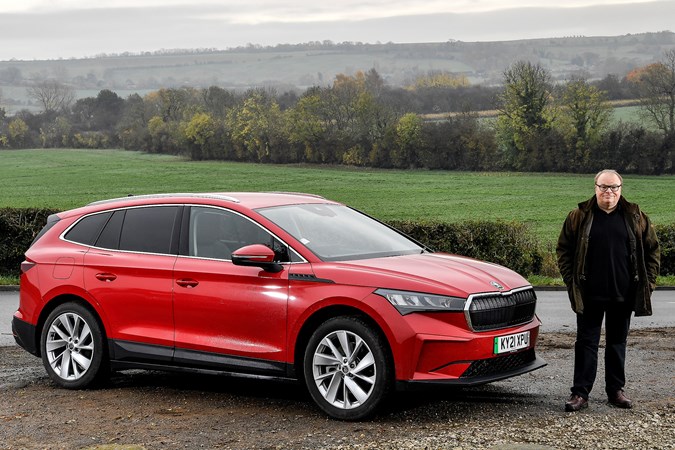
Jump to:
- Cabin and controls
- Range and charging
- Performance and handling
- Second (and third) opinion
- Comparing the Enyaq iV with a Kodiaq
- Verdict: What we found in six months
Update 1: Welcome
Introducing the Skoda Enyaq iV 80 82kWh Loft
Welcome to the extended long-term review of our 2022 Car of The Year. The Enyaq iV has impressed everyone on the Parkers team every time we’ve had one on test – so much so, that when we came to voting for our best car it was the first time the team was unanimous, and there were no arguments.
It’s a large family SUV that was launched in 2020 with a large lineup of models. Considering it shares so much technology with the Volkswagen ID.4 and Audi Q4, it stands apart from its sister cars in terms of appeal. Currently, it’s available with three motor/battery combinations, with the lower-powered shorter-range 60 coming in at less than £35,000.
We’ve gone for the Enyaq iV 80, which has an 82kWh battery and 204hp motor for a maxumum claimed range of 332 miles. Will it match those claims? We’ll get back to that in a later update.
Check out the Skoda Enyaq iV specs page on Parkers for the entire range – especially worth bearing in mind as not all trim packs are available with both motors.
What you get with an Enyaq iV Loft
As standard, our Enyaq iV weighs in at £39,365, which means you’ll not be entitled to the Government Plug-in Car Grant for electric cars. Being a Loft it’s a well-equipped all-rounder, but a short distance from the top of the range. As such you miss a few items such as heated seats or a leather interior, although thanks to a range of option packs, you can optionally specify them. So, it feels stocked with kit, but hardly luxurious. Here are the main features you get as standard:
- 13.0-inch touchscreen for infotainment
- 50kW – DC battery charging
- Chrome roofrails and window surrounds
- Cruise control and speed limiter
- Aluminium interior trim
- Heated, electrically adjustable, folding and auto
dimming door mirrors with boarding spots and welcome logo - Drive mode select
- Dual-zone climate control
- Keyless Stop/Start system
- Lane assist
- LED Ambient lighting
- LED headlights, daytime running lights and headlight
range control - Parking sensors front and rear
- Rear view camera
- Satellite navigation system
- Skoda Connect – Infotainment and remote services
- WiFi hotspot (in-car WiFi) for up to eight devices
So, it’s not exactly short of equipment as standard. But despite that, we’ve picked £3,600-worth of optional extras, which I’ll go through in the next update. The sheer breadth of option packs available for the Enyaq iV is confusing, and to get the car in the spec you really want, be prepared to spend some time on Skoda’s configurator.
Being an Enyaq iV 80, I’m expecting a decent range in day-to-day driving, and a car that I can comfortably pound the motorway on my regular 250-mile journey to my family in the north of England without stopping every 10 minutes for a recharge. Skoda claims up to 332 miles for this car, and my own experience is that it’ll do 260 miles comfortably at motorway speeds. That’ll do nicely.

It’s being sold as an SUV, and being a member of the modern world, I accept that these cars won’t be going off-road any time soon. What it does mean is a large and practical interior, lots of family-friendly functions and a rugged demeanor that happily shakes off all that modern life throws at it.
The interior lacks a little in the plushness stakes and I’d probably specify it in a lighter hue with a panoramic roof. But all of my friends who have been in it (and two have so far ordered Enyaq iVs!), have been impressed, liking the fabric-trimmed dashboard and large and easy-to use touchscreen. It’s roomy too, with a six-footer fitting happily in the rear behind another six-footer.
Over the coming months and thousands of miles, I’ll get deep under the skin of the Enyaq iV and regularly using Britain’s motorways to see if it really is possible to take an electric car on as a no-compromise replacement for your family petrol or diesel. I can’t wait – I’m a big fan already – and I’m looking forward to performing a really detailed long-term test.
Update 2: Cabin, equipment and options
What’s the Enyaq iV like to spend time in?
Long story short – the Enyaq’s interior is well put together, looks good, is roomy and is quite user friendly. And overall, I like it a lot although I wish it were brighter.

The electric car market is yet to fully mature, so the Enyaq iV comes up against an odd basket of rivals. Some are similarly priced and smaller, while others stand toe-to-toe with it, but cost you more money. The situation will change, but right now (and aside from MG’s bargain offerings) the Skoda is looking like great value for money, offering bags of room and a large interior that will swallow five people and their luggage with ease.
Its closest rival is probably the Volkswagen ID.4, which has been styled inside to challenge. The Skoda on the other hand looks relatively vanilla – a postitive for those looking to move across from something like an Octavia or Kodiaq without shouting look at meeeee! In the 1,500 miles I’ve done in it so far everyone I’ve talked to about this car have been very favourable about the way it looks.
Optional extras: sorting the wheat from the chaff
I touched on the generous standard equipment of the Enyaq iV in Loft spec in my last update, but the optional extra fitted make for interesting reading. Here’s what’s been added:
- 20-inch Vega Silver Metallic Alloys: £530
Not worth it… They don’t look that special, and ride quality takes a hit over the standard 19-inch wheels.
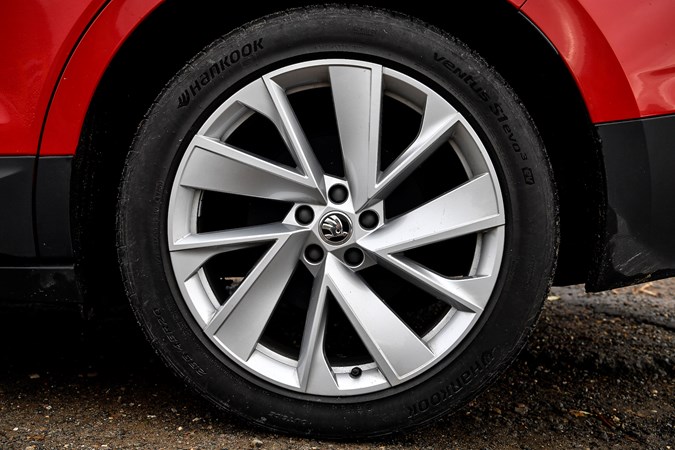
- 125kW – DC Battery Charging: £440
Too early to tell… I’ve been doing plenty of motorway miles but have yet to encounter a public charger capable of pushing out more than 50kW charge
- Assisted Drive Package Basic: £685
Includes: Adaptive cruise control, Blind spot detection, lane assist with traffic jam assist
Worth it… The adaptive cruise isn’t perfect, but works well in conjuction with speed-sign recognition to take the strain out of long-distance trips
- Comfort Seat Package Basic: £440
Includes: Electrically adjustable drivers seat with memory function. Power adjustable lumbar support for driver’s seat
Worth it… but only just as this is pricey for something that really should be standard
- Convenience Package Basic: £725
Includes: Keyless entry and start/stop system, wireless charging, privacy glass and acoustic side windows and driver alert system
Worth it… Keyless entry is an essential comfort feature these days, and I love how it’s just ‘on’ and ready to go as soon as you get in
- Drive Sport Package Basic: £200
Includes: Two-spoke leather heated multi-function steering wheel with paddles for recuperation level selection, drive mode
Worth it… Drive mode works well. although those steering wheel paddles aren’t really that useful when I drive in B mode for maximum recuperation anyway
- Metallic Paint/Pearlescent: £595
Worth it… Although red isn’t the Enyaq’s strongest colour
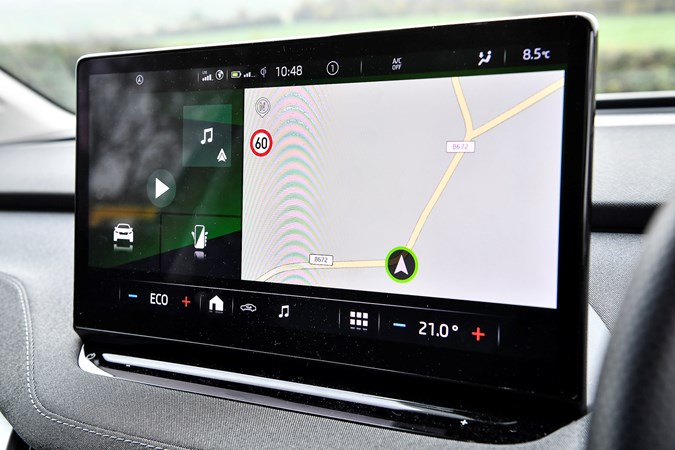
Infotainment and tech
Dominating the interior is the large, centrally-mounted 13.0-inch infotainment display with built-in 3D navigation, and unlike previous Volkswagen Group cars I’ve driven recently, this one has yet to crash or fall over. The sheer size makes it easy to operate – with just the silly touch-controlled pad for the volume control nestling beneath it where you’d normally rest your hand when operating it being an annoyance.
It’s very clear, sharp and easy to get your head round, and the only criticisms I have of it is that it’s not angled towards the driver, looks awful when covered in fingerprints and it’s mounted so high it means the fresh air vents are pushed lower down into the cabin, just like the Octavia.
Many of the car’s features are handled on this screen, so the interior looks almost basic, but the good news is that it integrates with wireless Apple CarPlay and Android Auto extremely well. The Skoda Connect services that come with it seem quite basic (I can check on battery status and pre-heat the cabin), but I’ll test it further in the coming months.
Update 3: Range and charging
How far does it go on a charge and how much does it cost?
Long story short – the Enyaq hasn’t got close to matching the claimed 336-mile range, but it’s still very capable of long distances when driven carefully.

Sometimes it’s easy to forget the fundamentals when reviewing something as capable as the Enyaq iV. That appears to be the case here because I’ve been happily living with – and charging – it for months and yet, I’ve not really discussed public and private charging, and how far it actually goes on with 100% on the gauge.
As we were enjoying some unseasonably mild weather when I picked up the Enyaq iV in September 2021, I expected some impressively long and uninterrupted drives in it. And so it proved, with an average of 3.7 miles per kWh combined with that large 80kWh battery meaning a very easy 250+ miles on the daily commute. And as you’ve already read, that is nowhere near the claimed 336 miles.
After a full recharge, the displayed range is estimated from your last time spent in the car, which generally proved reliable – and what I’ve been finding is that it’s reporting between 260 and 280 miles depending on where I’ve been taking it. The lower figure represents time spent on the motorway, with the higher estimate reflecting lower-speed A- and B-road commuting.
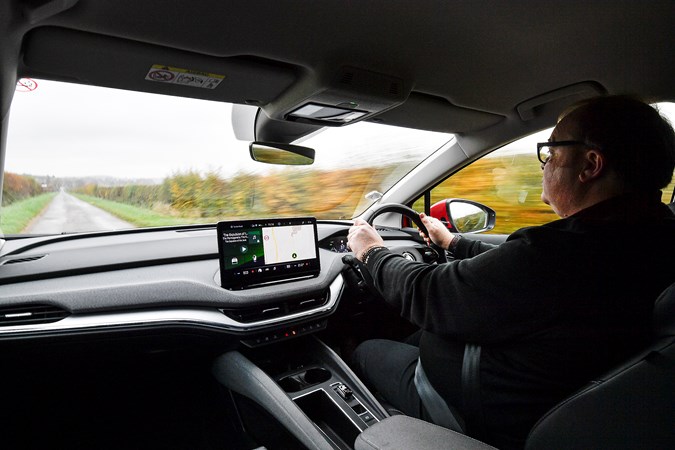
In reality, I’m finding it pretty easy to live with, although to be fair, it’s far from being my first electric car, so I am used to all the foibles that come with public charging. For one, I have a regular trip from the East Midlands to West Cumbria, and this is the first EV that I’ve owned that I really don’t find a chore doing the trip in.
Admittedly I don’t have a homecharger up north, and there’s a real shortage of public top-up points in West Cumbria, so I have an enforced stop on the way up in order to arrive with plenty of ‘gas’ in the tank. That’s seen me using a BP Pulse hub in Lancaster, which although has plenty of chargers, is a desolate place. The sooner we get EV hubs with coffee shops built in, the better.
Driving back from the North is always easier – I have a chargepoint at home, which means I shouldn’t need to stop. And so it proves. At a steady 65-70mph on the M6/A50/M1, I can do this 260-mile trip non-stop without too much stress, although some EV regulars reckon that me getting home with just 15 miles of range is a little squeakier than they would like.
How much does it cost?
Well, I don’t have a particularly good electricity deal right now (do any of us?) which means I’m paying 19.35p/kWh for my juice. Be that as it may, it’s still considerably cheaper than fuelling up a petrol or diesel when charging at home. A typical 70kW change (near-empty to full) comes in at £13.54, which isn’t half bad for the 200-plus miles I’m going to get from that.
Public charging opens you up to higher cost as I found the first time I drove the Enyaq from Scotland to England using Ionity chargers. The cost of these is 69p/kWh which places it in similar territory to running a diesel – although this cost reduces if you open an account.
I’ve done just this with BP Pulse, as its cost comes down from 35p per kW to 26p, although you have to pay a £7.50 monthly subscription for this, which I reckon right now I am not quite covering the cost of. So do check your mileages before taking out a subscription. However, the ease of tap ‘n’ go payments is good. Not so, the sheer amount of dead public chargers I am finding out and and about.
But which ever way you stack it, running an EV is still significantly cheaper than a petrol or diesel. Just make sure you can pick up as much juice as you can at home.
Update 4: Performance and handling
How quick is it and how well does it drive?
Long story short – it’s smooth and effortless, but won’t set your pulse racing. But do you really want it to?
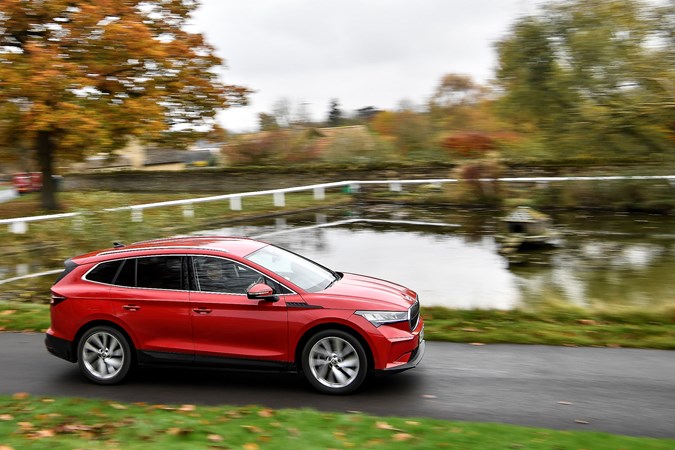
I won’t go into too much detail here because we cover this facet of Enyaq iV ownership more thoroughly in the how it drives section of the review. However, it is definitely worth saying that as the electric car market matures, carmakers are beginning to work out how to engineer in some ‘feel’ into these cars after decades of perfecting those powered by an internal combustion engine.
In the case of the Skoda Enyaq iV, it’s very much about solidity and feeling planted on the road. So it’s been given quite a firm ride in order to tie the suspension down in corners. There’s a price to be paid in terms of overall comfort, which we’ll come back to in a later report, but in bends it’s safe and secure – something of an achievement for a car that weighs this much (1,890kg).
It’s not exciting, though, but is that really a priority in a family SUV? On the motorway, it’s especially good – both quiet and stable, and capable of eating up miles with no real downsides (once you stop looking at the range indicator).
Performance
I have to say that I really like the way it goes. It’s quick enough off the blocks, with a 0-62mph time of 8.6 seconds, and delivers plenty of mid-range overtaking punch when required. If you’re stuck behind someone ambling at 40mph on a National Speed Limit section of A-road, getting past them is a cinch – just press and go. Here, the Enyaq lifts its skirts and flies by quickly and safely. Even in Eco mode.
The smoothness of the power delivery is what makes the Enyaq iV, though, because once you’re acclimatised to the sensitive accelerator pedal. You can minutely adjust the level of acceleration to your needs and enjoy a seamless surge forwards. Going back to petrol or diesel after time in the Enyaq iV can feel like a backwards step.
Update 4: Second (and third) opinion
Potential Enyaq buyers spend time in our Car of The Year
Long story short – the Enyaq managed to convince someone considering an EV that they could make the switch from petrol.
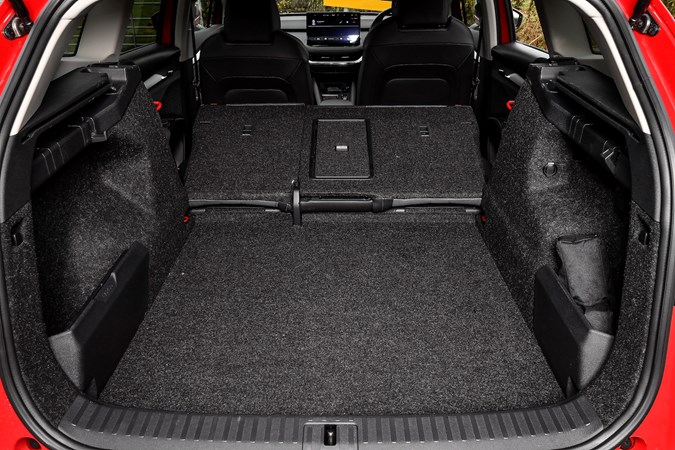
Group Editorial Director Tim Pollard borrows the Enyaq for a week, here are his findings:
Tim came back gushing about the spacious interior. Fully grown adults can fit comfortably in either row and it’s dripping with little touches that make family life better. He raved about details such as the separate phone pouches on the seatbacks to hold passengers’ mobiles, the quartet of shopping bag hooks in the boot and the hushed refinement that makes for better-quality conversation with children in the back seats.
He was involved in ferrying around members of a hockey team and noted how easily the Enyaq’s boot swallowed a vast goalkeeper’s bag with room to spare. ‘This is really practical, sensible family transport and it’s great to live with the reigning Parkers Car of the Year,’ he said. ‘Daily exposure just reinforces its qualities. It deserves all the plaudits we commended in last year’s awards.’

It’s not without its flaws though. Tim was unimpressed when the infotainment system crashed – the screen freezing completely when synced with his iPhone. This was especially annoying in mid-winter, as the heating controls are digital and he couldn’t operate the demisting function.
A quick off-on reset fixed things, but we’ve suffered enough gremlins with Vokswagen Group digital controls that it’s knocked our confidence somewhat. Tim also noted how the attractive, cloth-bound panel beneath the screen looks nice and is soft to the touch, but creaks and moves when a hand rests on it to use the touchscreen.
‘Living with the Enyaq for a few days highlighted a few grumbles, but overall it’s a cracking electric car bristling with practical touches. It brings all the usual Skoda virtues to an EV and makes plugging in and switching over from petrol or diesel cars so easy for family motorists – especially with the larger-batteried 80 model we’re testing.’
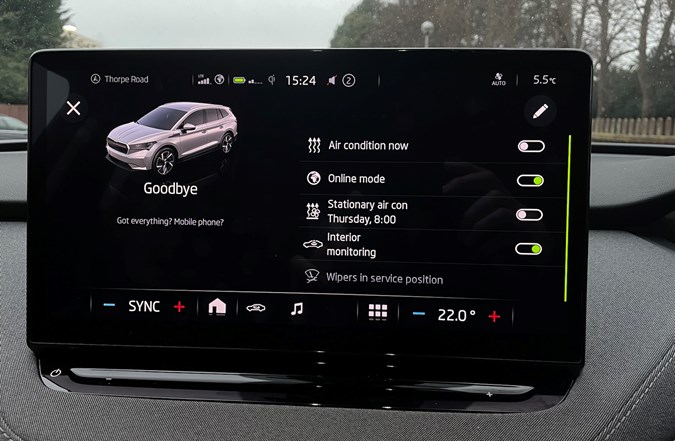
Commercial director, Jim Burton uses the car for a week, and he comes away impressed. Here’s what he found:
As an existing SEAT Tarraco owner, and a family man who uses his car for business trips, he’s very interesed in making the switch to electric. He liked the way it drives, saying, ‘first impressions are that it is very stable but quite heavy in corners. It has very smooth acceleration and is also smooth to drive overall.
‘It was pretty easy to drive once I was used to the regenerative braking, but then I am used to that from motorcycling days. For that reason alone, I’d move to electric power. However, I was expecting lots more visual tech from it rather then just the big TV in the middle of the dashboard.
‘So, for a driver’s car, I like it but the passengers were not sold on it. They also had some range anxiety, but I made it to London and back (160 miles) on a full charge so was suitably impressed. If I owned one, I’d definitely need to buy a wallbox at home. In conclusion, I’d be happy with a Skoda but when spending this much money, I’d want a slightly more premium interior. In the end, the drive sold it for me more than the interior and tech.’
Update 5: Comparing with a petrol Kodiaq
We pitch our 2022 Car of The Year winner against its petrol-powered equivalent
Long story short – the Enyaq has acquitted itself really well as a family car over an extended period – but how much do we miss the convenience of petrol?

You’ve probably already worked out that we really like the Skoda Enyaq iV. Yes, it’s our Car of The Year for 2022, and all that entails, but that’s just part of it. It’s worked itself perfectly into family life by being accommodating, easy to drive, and capable of travelling a reasonable amount between recharges. But does that mean it’s good enough to replace a petrol car for the majority of people? Let’s found out…
Our Kodiaq is a 2.0-litre TSI petrol, boasting 190hp and looking good in Sportline spec. In reality it’s actually quite close to our Enyaq iV in terms of power and performance, although it boasts seven-seater capability, which our electric car doesn’t have. It’s a DSG auto, which means it’s as simple to drive as my EV, too – just a case of turning it on and going where we want to.
Functionally, the Kodiaq has the flexibility of three rows of seats over the Enyaq, but in every other way, the electric SUV has the advantage. The interior is brighter, better finished and just looks a whole lot more appealing. On the road, and once reacclimatised to the hardship of firing up an engine, they’re a bit closer. The Kodiaq is quicker accelerating – 0-62mph comes up in 7.8 seconds compared with 8.6 for the Enyaq, while if you go to Germany, you’ll happily be able to cruise all day long at three-figure speeds. This is not something our electric Enyaq iV is capable of.
The scores on the doors
But to drive, the Enyaq does win over. The acceleration is smooth and linear, and like all good EVs, it’s so easy to moderate your speed with just your right foot, thanks to regenerative braking. It’s refined and effortless, and an absolute joy in this department. The Kodiaq’s brilliant petrol engine is refined and economical, but it simply can’t compete with the EV; when back-to-back, it feels like you’re endlessly waiting for the revs to rise, or the DSG to change into the right gear. This is all relative, of course.
However for those who are towing or are travelling long distances regularly, the convenience of petrol wins back significant Brownie points. Yes, the cost of filling up from the green pump mounts up on a daily basis, but if you’re on a long trip, a five-minute stop buys you up to 500 miles. Compare that with approximately an hour or so for 200 miles on an 50kW public charger, and the difference is stark. However, it’s costing upwards of £100 to fill-up the Kodiaq these days – which compares to £20 or so to do the same for the Enyaq on a public charger.
So, in a nutshell, it comes to your lifestyle, how many miles you do, and where you live. The Enyaq is an easy winner if you don’t have call to use public chargers on a regular basis, and aren’t racking up huge mileages. It’s nicer to steer, is better to sit in, and the costs of refuelling it are significantly lower. It will also be worth considerably more after three years. However, if you can’t have an EV wallbox, live in a place that’s short of decent public chargers, and regularly tow, then the Kodiaq is an excellent alternative.
Who’d have thought we’d say that, just five years ago!
Update 6: Verdict – what did we find?
After six months behind the wheel of the Skoda Enyaq iV, how did we find our Car of The Year to live with? Keith Adams spills the beans.
Long story short – if you’re going to buy an electric family car, this is the current state of the art. There are flashier rivals, but the Skoda’s combination of value, quality and drivability are still unbeatable.
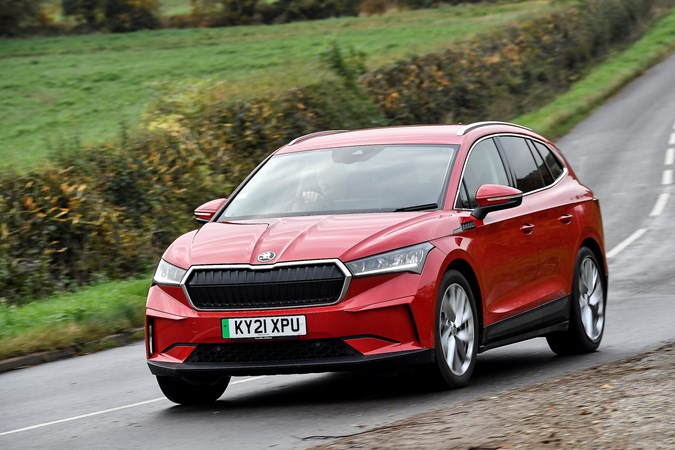
We’ve pounded the motorways, commuted our way across the UK and pottered in the Skoda Enyaq iV. In six months of running our 2022 Car of The Year, we can now confirm that it is every bit as good as we’d found in those early drives which impressed us so much – it’s comfortable, spacious, has a lovely interior and enough usable range to make it feasible for most families to make the switch to electric. That’s if you don’t mind waiting – as I write this, the waiting list for some Enyaq iV models stretches out to 18 months.
There was lots of good news during our extended period spent with the Enyaq iV – covering miles in it was an absolute cinch. The interior is probably the Enyaq’s best aspect, being light and airy, well constructed and trimmed in some very appealing materials. It’s a good motorway cruiser and aside from a slightly unsettled ride, it it puts in a great show dynamically.
It’s not perfect, though. It’s expensive when you start hitting the options packs, and despite that headline-grabbing 336-mile range, I never managed to beat 280 miles on a full charge, gently driven in mild summer weather. It’s still a good real-world range, but it could be argued that’s more an issue with the WLTP testing regime. But while manufacturers quote these figures, potential buyers will have a false expectation.
Sadly, a lot of the Enyaq’s good work is undone by the limitations in the UK’s charging infrastructure. As electric cars become more popular, the roll-out of public chargers has failed to keep pace, leading to increasing frustration for long-distance EV drivers. But that’s more of a lifestyle question, rather than one about the Enyaq iV – for those with their own homecharger, and who won’t be doing too much plugging-in on the go, I’d say go for it! You won’t be disappointed.
| Skoda Enyaq iV 80 82kWh Loft | |
| Total mileage (six months) | 9,350 |
| Electrical efficiency | 3.4 miles per kWh |
| Parkers real-world range | 264 miles |
| Parkers ‘MPP’ (Miles Per Pound) calculation | 6.8/20.0 (home/public charging) |
| Car joined Parkers fleet | September 2021 |
